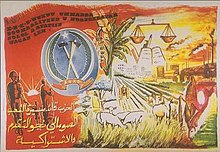Somali Revolutionary Socialist Party
 | |
| General Secretary | Siad Barre |
| Founder | |
| Founded | 26 June 1976 (founding congress)[1] 1 July 1976 (election of first Central Committee)[1] |
| Dissolved | 26 January 1991 |
| Headquarters | Mogadishu |
| Membership (1990) | 20,000 |
| Ideology | Islamic socialism Marxism–Leninism Pan-Somalism Scientific socialism Somali nationalism Militarism |
| Religion | Sunni Islam |
| Colours | Red Blue |
The Somali Revolutionary Socialist Party (Somali: Xisbiga Hantiwadaagga Kacaanka Soomaaliyeed, XHKS; Arabic: الحزب الاشتراكي الثوري الصومالي, al-Ḥizb al-ishtirākī at-thawrī as-ṣūmālī; Italian: Partito Socialista Rivoluzionario Somalo) was the ruling party of the Somali Democratic Republic from 1976 to 1991.
History[]

SRSP was created by the military regime of Siad Barre under Soviet guidance. A founding congress was held in June 1976. The congress elected a Central Committee, with Barre as the party general secretary. A five-member politburo, consisting of Barre, Lt. General Muhammad Ali Samatar (vice president), Major General Husseen Kulmiye (2nd vice president), Brig. and Brig. (who was later replaced by Brig. ) was constituted. Party cadres also included prominent socialists such as , , and (a well known socialist economist) and .
During a brief period, prior to the escalation of conflict with Ethiopia in 1977, XHKS developed relations with foreign communist parties, such as the Communist Party of the Soviet Union (CPSU) and Socialist Unity Party of Germany (SED). CPSU initiated a programme of assistance for the SRSP party school. After relations with the Soviet Bloc were ruptured, a group including SRSP CC member broke away to form splinter groups. This was even further accelerated by the failed military coup of April 9, 1978, popularly known as "Nova Aprile". In 1981 dissident factions would emerge as the Democratic Front for Salvation of Somalia.
When Barre's regime fell in 1991, SRSP disappeared. In the same year the Somali National Front was organized by Barre loyalists.
Ideology[]

The SRSP was in theory a Marxist–Leninist party, but also included Islamic socialism, scientific socialism, Somali nationalism and pan-Somalism teachings in its ideology. It was dissolved when Mohamed Siad Bare was ejected from power in late 1991.
Organisation[]
The SRSP was supposed to function as a political force transcending clan lines, but in reality there was little change in political practice. Power was concentrated to three clans. The party developed an intelligence branch, Baadhista xisbiga, which worked parallel to state intelligence and paramilitary groups. At most SRSP had around 20,000 members. XHKS held its 3rd Congress in November 1986. A major reshuffle of the Central Committee took place.
Role in Somali government[]

The Seventh Article of the 1979 constitution of the Somali Democratic Republic clarified the role of XHKS:
Authority and Leadership of the Party
- The Somali Revolutionary Socialist Party shall be the only legal party in the Somali Democratic Republic; no other party or political organisation may be established.
- The Somali Revolutionary Socialist party shall have supreme authority of political and socio-economic leadership in the Somali Democratic Republic.
Electoral history[]
Presidential elections[]
| Election | Party candidate | Votes | % | Result |
|---|---|---|---|---|
| 1980 | Siad Barre | 171 | 100% | Elected |
| 1986 | 4,887,592 | 99.97% | Elected |
Note
After the 1979 election, the People's Assembly elected Barre President on 26 January 1980.
People's Assembly elections[]
| Election | Party leader | Votes | % | Seats | +/– | Position | Outcome |
|---|---|---|---|---|---|---|---|
| 1979 | Siad Barre | 3,982,532 | 99.95% | 171 / 177
|
Sole legal party | ||
| 1984 | 4,207,977 | 99.89% | 171 / 177
|
Sole legal party |
See also[]
References[]
- ^ Jump up to: a b Mukhtar, Mohamed Haji (2003-02-25). Historical Dictionary of Somalia. Historical Dictionaries of Africa (Revised ed.). Scarecrow Press. p. 237. ISBN 978-0-8108-6604-1.
- Formerly ruling communist parties
- Parties of one-party systems
- Political parties established in 1976
- Political parties disestablished in 1991
- Defunct political parties in Somalia
- Communism in Somalia
- Socialist parties in Somalia
- Communist parties in Africa
- Somali nationalism
- Islamic political parties in Somalia
- Islamic socialist political parties
- 1976 establishments in Somalia
- 1991 disestablishments in Somalia
- 1970s in Somalia
- 1980s in Somalia